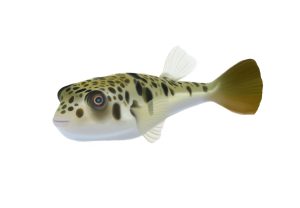Fugu chefs in Japan undergo three years of intensive training to prepare poisonous puffer fish so they can be safely eaten.
But toxic puffer fish aren’t restricted to Japanese waters.
There’s a species of puffer fish that is very common in South Australia. Known as the smooth toad fish, it’s also dangerously poisonous.
Central Adelaide Local Health Network (CALHN) Resident Medical Officer Dr Emily Burton recently reported the case of a man who became seriously ill after catching a puffer fish on a suburban Adelaide beach and eating it for dinner.
“The man arrived at the emergency department with vomiting, dizziness and weakness,” says Dr Burton.
“He also reported numbness and tingling in his hands and feet, and around his mouth.”
Over the next 72 hours the man’s symptoms significantly improved with supportive care and he was discharged home.

Toxin that survives cooking
Puffer fish flesh contains a poisonous chemical known as tetrodotoxin, which has effects on nerves, heart and skeletal muscles when eaten.
Tetrodotoxin is not diminished by cooking, cleaning or freezing.
Tetrodotoxin toxicity symptoms typically begin 30 to 90 minutes after eating, and range from mild tingling, numbness and nausea to full paralysis, low blood pressure and respiratory failure. Death has been reported as little as 17 minutes after ingestion, however those who survive 24 hours post ingestion usually fully recover.
There is no effective antidote for tetrodotoxin and treatment is primarily supportive. In severe cases, patients may require admission for intensive care.
Puffer fish can also create severe illness in dogs.
Sharing knowledge for better care
Dr Burton presented the case study A Fish Out of Water at the Australian and New Zealand Association of Neurologists 2024 Scientific Meeting, and published a report in the journal Practical Neurology.
“The case did attract a bit of attention and conversation given its rarity,” Dr Burton says.
“I think most doctors (and members of the public) are aware that consuming pufferfish can be dangerous given it is a well-known delicacy in Japan.”
“However I don’t think many people, including myself, were aware you could catch one in Australian waters and consume it unknowingly,” says Dr Burton.

Dr Burton explained that while senior doctors may have seen one or two cases of puffer fish toxicity in their lifetime, junior doctors typically had not.
“Symptoms of neurotoxicity can also be variable in their presentation and severity, so it was a helpful learning case for all involved and highlighted the importance of taking a thorough history,” says Dr Burton.
A patient history involves speaking with the patient or family members about their symptoms, recent activities, past medical and surgical history, allergies and other factors.
More cases on the horizon
Dr Burton said it made sense for doctors to remain alert to possible cases of toxicity due to accidental eating of poisonous puffer fish.
“Increasing global water temperatures mean that marine species containing tetrodotoxin may migrate to a wider geographical range,” she says.
“Doctors need to be familiar with symptoms of toxicity and be aware of possible rapid deterioration.”
Co-authors on the case study are from the Royal Adelaide Hospital, University of Adelaide, SA Pathology, Lyell McEwin Hospital and Flinders University, and include Alastair Ward, Lachlan Tamlin, Shaddy El-Masri, Rudy Goh, Roula Ghaoui and Stephen Bacchi.
CALHN Resident Medical Officers Dr Kaiying Wang and Dr Dominic Spicer also presented case studies at the conference.
Puffer fish digital image created by Dr Emily Burton.
Learn more about South Australian puffer fish here.



